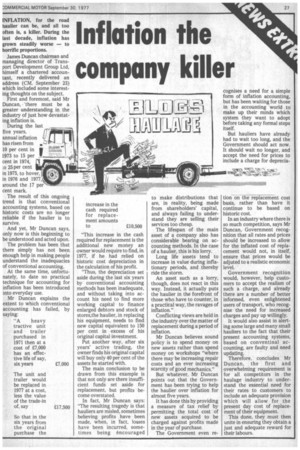Inflation the company killer
Page 29

If you've noticed an error in this article please click here to report it so we can fix it.
INFLATION, for the road haulier can be, and all too often is, a killer. During the last decade, inflation has grown steadily worse — to horrific proportions.
James Duncan chairman and managing director of Transport Development Group Ltd, himself a chartered accountant, recently delivered an address (CM, September 23) which included some interesting thoughts on the subject.
First and foremost, said Mr Duncan, 'there must be a greater understanding in the industry of just how devastating inflation is.
During the last five years, annual inflation has risen from ....10 per cent in g 1973 to 15 per cent in 1974, :025 per cent in 1975, to hover, in 1976 and 1977, xround the 17 per cent mark.
The result of this ongoing trend is that conventional accounting systems, based on historic costs are no longer reliable if the haulier is to survive.
And yet, Mr Duncan says, only now is this beginning to be understood and acted upon.
The problem has been that there simply has not been enough help in making people understand the inadequacies of conventional accounting. At the same time, unfortunately, to date no practical technique for accounting for inflation has been introduced into everyday use.
Mr Duncan explains the extent to which conventional accounting has failed, by saying: "A heavy tractive unit and trailer purchased in 1971 then at a cost of £7,000 has an effective life of say, six years £7,000 The unit and trailer would be replaced in 1977 at a cost, less the value of the trade-in of, say £17,500 So that in the six years from the original purchase the increase in the cash required for replacement amounts to £10,500 "This increase in the cash required for replacement is the additional new money an owner would require to find, in 1977, if he had relied on historic cost depreciation in the calculation of his profit.
"Thus, the depreciation set aside during the last six years by conventional accounting methods has been inadequate, and without taking into account his need to find more working capital to finance enlarged debtors and stock of stores,the haulier, in replacing his equipment, needs to find new capital equivalent to 150 per cent in excess of his original capital investment.
Put another way, after six years' active trading, the owner finds his original capital will buy only 40 per cent of the assets he started with.
The main conclusion to be drawn from this example is that not only are there insufficient funds set aside for replacement, but profits become overstated.
In fact, Mr Duncan says: "The resulting tragedy is that hauliers are misled, sometimes believing profits have been made, when, in fact, losses have been incurred, sometimes being encouraged to make distributions that are, in reality, being made from shareholders' capital, and always failing to understand they are selling their services too cheap.
The lifespan of the main asset of a company also has considerable bearing on accounting methods. In the case of a haulier, this is his lorry.
Long life assets tend to increase in value during inflationary periods, and thereby ride the storm.
An asset such as a lorry, though, does not react in this way. Instead, it actually puts the haulier in the forefront of those who have to counter, in a practical way, the ravages of inflation."
Conflicting views are held in the industry over the matter of replacement during a period of inflation.
Mr Duncan believes sound policy is to spend money on new assets rather than spend money on workshops "where there may be increasing repair costs and an ever increasing scarcity of good mechanics."
But whatever, Mr Duncan points out that the Government has been trying to help the haulier over inflation for almost five years.
It has done this by providing a measure of tax relief by permitting the total cost of new assets acquired to be charged against profits made in the year of purchase.
The Government even re cognises a need for a simple form of inflation accounting, but has been waiting for those in the accounting 'world to make up their minds which system they want to adopt before taking any formal steps itself.
But hauliers have already had to wait too long, and the Government should act now. It should wait no longer, and accept the need for prices to include a charge for deprecia tion on the replacement cost basis, rather than have it continue to be based on historic cost.
In an industry where there is so much competition, says Mr Duncan, Government recognition that all rates and prices should be increased to allow for the inflated cost of replacement would not, in itself, ensure that prices would be adjuted to a realistic economic level.
Government recognition would, however, help customers to accept the realism of such a charge, and already there are a number of better informed, even enlightened users of transport, who recognise the need for increased charges and pay up willingly.
It would also assist in alerting some large and many small hauliers to the fact that their present accounting systems, based on conventinal accounting, are faulty and need updating.
Therefore, concludes Mr Duncan, the first and overwhelming requirement is for all competitors in the haulage industry to understand the essential need for their rates to customers to include an adequate provision which will allow for the present day cost of replacement of their equipment.
This done, they must then unite in ensuring they obtain a just and adequate reward for their labours.






































































































